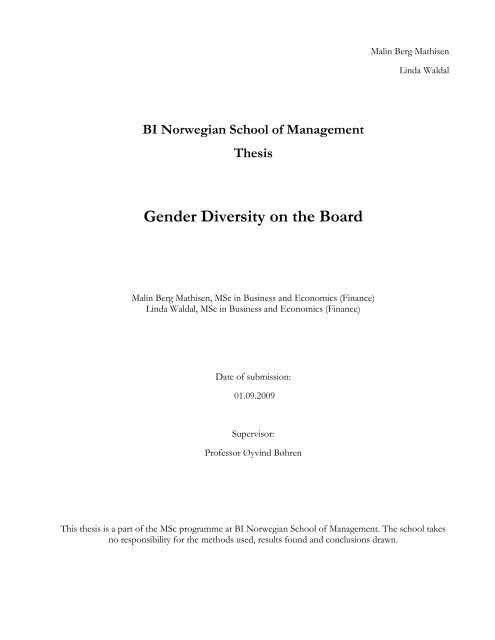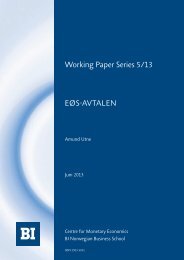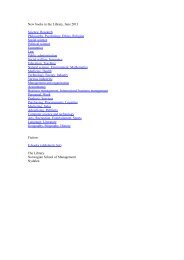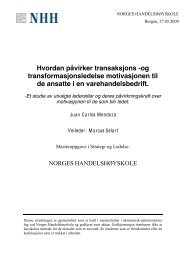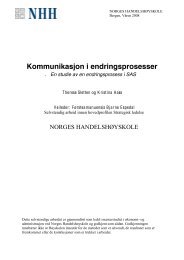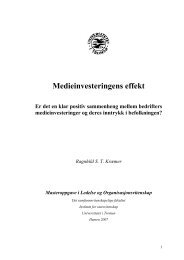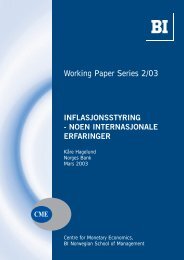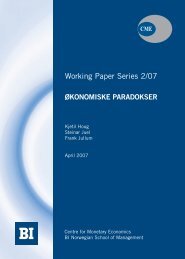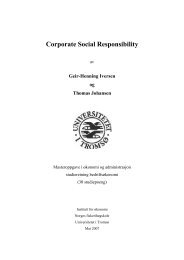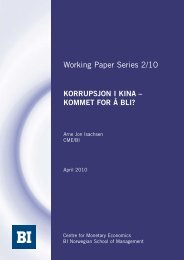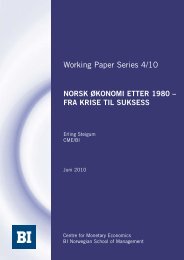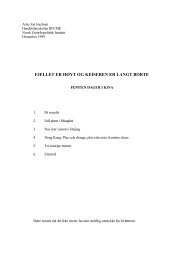Gender Diversity on the Board - BI Norwegian Business School
Gender Diversity on the Board - BI Norwegian Business School
Gender Diversity on the Board - BI Norwegian Business School
You also want an ePaper? Increase the reach of your titles
YUMPU automatically turns print PDFs into web optimized ePapers that Google loves.
Malin Berg Mathisen<br />
Linda Waldal<br />
<strong>BI</strong> <strong>Norwegian</strong> <strong>School</strong> of Management<br />
Thesis<br />
<str<strong>on</strong>g>Gender</str<strong>on</strong>g> <str<strong>on</strong>g>Diversity</str<strong>on</strong>g> <strong>on</strong> <strong>the</strong> <strong>Board</strong><br />
Malin Berg Mathisen, MSc in <strong>Business</strong> and Ec<strong>on</strong>omics (Finance)<br />
Linda Waldal, MSc in <strong>Business</strong> and Ec<strong>on</strong>omics (Finance)<br />
Date of submissi<strong>on</strong>:<br />
01.09.2009<br />
Supervisor:<br />
Professor Øyvind Bøhren<br />
This <strong>the</strong>sis is a part of <strong>the</strong> MSc programme at <strong>BI</strong> <strong>Norwegian</strong> <strong>School</strong> of Management. The school takes<br />
no resp<strong>on</strong>sibility for <strong>the</strong> methods used, results found and c<strong>on</strong>clusi<strong>on</strong>s drawn.
GRA 19001 Master Thesis<br />
C<strong>on</strong>tents<br />
Abstract ...........................................................................................................................................3<br />
Acknowledgement .........................................................................................................................4<br />
1 Introducti<strong>on</strong> ...........................................................................................................................5<br />
1.1 Motivati<strong>on</strong> ......................................................................................................................5<br />
2 Theory and existing evidence ..............................................................................................7<br />
3 Methodology ....................................................................................................................... 12<br />
3.1 Hypo<strong>the</strong>ses ................................................................................................................. 12<br />
3.1.1 Hypo<strong>the</strong>sis 1 ....................................................................................................... 12<br />
3.1.2 Hypo<strong>the</strong>sis 2 ....................................................................................................... 13<br />
3.1.3 Hypo<strong>the</strong>sis 3 ....................................................................................................... 14<br />
3.2 CCGR-database .......................................................................................................... 14<br />
3.3 Filtering process ......................................................................................................... 14<br />
4 Descriptive statistics .......................................................................................................... 16<br />
4.1 Dependent variable .................................................................................................... 19<br />
4.2 Independent variables ............................................................................................... 20<br />
5 Statistical tests ..................................................................................................................... 22<br />
5.1 Base-case model ......................................................................................................... 22<br />
6 Robustness .......................................................................................................................... 25<br />
7 Summary and c<strong>on</strong>clusi<strong>on</strong>s ................................................................................................ 27<br />
7.1 Limitati<strong>on</strong>s .................................................................................................................. 28<br />
8 Bibliography ........................................................................................................................ 29<br />
Appendixes .................................................................................................................................. 31<br />
2
GRA 19001 Master Thesis<br />
Abstract<br />
In this <strong>the</strong>sis we examine <strong>the</strong> interacti<strong>on</strong> between firm characteristics and gender<br />
diversity in <strong>the</strong> boardroom, focusing <strong>on</strong> large n<strong>on</strong>listed firms. By studying certain<br />
governance characteristics in <strong>the</strong>se firms, we document that firms with diverse boards<br />
may differ from those with less diverse boards.<br />
Our results show that <strong>the</strong> share of family ownership in n<strong>on</strong>listed firms matters for<br />
gender diversity <strong>on</strong> <strong>the</strong> board. Higher share of family ownership is related positively to<br />
<strong>the</strong> share of female stockholder-elected board directors, and may suggest that more<br />
directors are recruited within families. C<strong>on</strong>sistent with our hypo<strong>the</strong>sis we document that<br />
<strong>the</strong> CEO being female, leads to more female stockholder-elected directors, indicating<br />
that <strong>the</strong> CEO seems to have an impact <strong>on</strong> corporate policies in n<strong>on</strong>listed firms. We find<br />
no evidence that performance interacts with gender diversity <strong>on</strong> corporate boards in<br />
n<strong>on</strong>listed firms.<br />
3
GRA 19001 Master Thesis<br />
Acknowledgement<br />
We would like to express our gratitude towards our <strong>the</strong>sis supervisor, Professor Øyvind<br />
Bøhren. Through Professor Bøhren we were introduced to <strong>the</strong> field of Corporate<br />
Governance and we are grateful for <strong>the</strong> knowledge we have gained <strong>on</strong> <strong>the</strong> area of study.<br />
He provided us with <strong>the</strong> initial topic for this <strong>the</strong>sis, as well as access to <strong>the</strong> CCGRdatabase.<br />
His feedback throughout <strong>the</strong> <strong>the</strong>sis process we c<strong>on</strong>sider invaluable and is<br />
highly appreciated.<br />
We would also like to thank William Birkeland for his great help during <strong>the</strong> process of<br />
extracting all necessary data from <strong>the</strong> CCGR-database.<br />
4
GRA 19001 Master Thesis<br />
1 Introducti<strong>on</strong><br />
1.1 Motivati<strong>on</strong><br />
<strong>Board</strong>s are set up to functi<strong>on</strong> as an extra instituti<strong>on</strong>al layer between owners and<br />
managers. The three major c<strong>on</strong>cerns in board design are to align <strong>the</strong> interests of<br />
principals and agents, provide informati<strong>on</strong> for m<strong>on</strong>itoring and support, and to enhance<br />
<strong>the</strong> board’s effectiveness as a decisi<strong>on</strong>-maker. However, in <strong>the</strong> process of designing a<br />
well functi<strong>on</strong>ing board, fundamental problems arise. In terms of decisiveness, <strong>the</strong><br />
questi<strong>on</strong> is whe<strong>the</strong>r <strong>the</strong> board should be big and diverse, increasing informati<strong>on</strong><br />
availability, or if <strong>the</strong> board should be small and homogenous, such that decisi<strong>on</strong>s are<br />
made quickly and effectively. Despite <strong>on</strong>going discussi<strong>on</strong>s around board politics, existing<br />
research c<strong>on</strong>cerning how firms’ characteristics and performance interacts with board<br />
diversity is modest.<br />
<str<strong>on</strong>g>Gender</str<strong>on</strong>g> mix may create diversity, without necessarily increasing board size, as it expands<br />
<strong>the</strong> opportunity set if men and women differ in relevant ways. The purpose of our paper<br />
is to examine <strong>the</strong> interacti<strong>on</strong> between firm characteristics and gender diversity, using <strong>the</strong><br />
share of female stockholder-elected directors as dependent variable. Our c<strong>on</strong>tributi<strong>on</strong><br />
may give grounds for understanding gender diversity at decisi<strong>on</strong>-making levels. This is<br />
important as part of studying <strong>the</strong> likeliness of success of governance proposals with<br />
regards to gender diversity <strong>on</strong> corporate boards.<br />
A limited liability firm can be ei<strong>the</strong>r an AS (aksjeselskap) or an ASA<br />
(allmennaksjeselskap). The ASA legal form is mandatory for listed firms. In Norway all<br />
ASA must abide by a 40% gender quota for female and male directors as this is required<br />
by law. However, more than 99% of <strong>Norwegian</strong> enterprises are n<strong>on</strong>listed AS firms, and<br />
thus not required to act in compliance with this quota. Our paper will address <strong>the</strong> board<br />
characteristics of n<strong>on</strong>listed firms. Research <strong>on</strong> <strong>the</strong>se firms is of interest since <strong>the</strong>y<br />
account for a much larger fracti<strong>on</strong> of value creati<strong>on</strong> than listed firms. Extensive research<br />
is d<strong>on</strong>e <strong>on</strong> listed firms, but <strong>the</strong>se findings may not be valid for n<strong>on</strong>listed firms. N<strong>on</strong>listed<br />
firms stand before different challenges than listed firms. In n<strong>on</strong>listed firms <strong>the</strong> owner<br />
c<strong>on</strong>centrati<strong>on</strong> is higher, <strong>the</strong>y have higher insider ownership, fewer board members, and<br />
5
GRA 19001 Master Thesis<br />
often individuals own <strong>the</strong> shares. These characteristics may matter for <strong>the</strong> firm’s<br />
behavior, according to <strong>the</strong>ory of corporate finance and governance.<br />
63% of all firms in Norway are family firms. A firm may be defined as a family firm<br />
when 50%, or more, of <strong>the</strong> shares are owned by pers<strong>on</strong>s related by marriage or kinship<br />
(Bøhren, 2009). Such a large fracti<strong>on</strong> of n<strong>on</strong>listed firms being classified as family firms<br />
makes it interesting to examine whe<strong>the</strong>r <strong>the</strong> extent of shares held by families affects<br />
gender diversity <strong>on</strong> corporate boards.<br />
The <strong>the</strong>sis is organized as follows. In secti<strong>on</strong> 2, we provide an overview over <strong>the</strong>ory and<br />
existing evidence. Secti<strong>on</strong> 3 discusses <strong>the</strong> methodology and hypo<strong>the</strong>ses. In secti<strong>on</strong> 4 <strong>the</strong><br />
descriptive statistics are presented, while secti<strong>on</strong> 5 and 6 discuss <strong>the</strong> statistical tests and<br />
<strong>the</strong> robustness tests.<br />
6
GRA 19001 Master Thesis<br />
2 Theory and existing evidence<br />
The principal-agent <strong>the</strong>ory predicts that when owners delegate to managers, agency costs<br />
are created since agents have incentives to pursue <strong>the</strong>ir own interests at <strong>the</strong> principals’<br />
expense (Jensen & Meckling, 1976). N<strong>on</strong>listed firms in general have higher ownership<br />
c<strong>on</strong>centrati<strong>on</strong>, leading to low separati<strong>on</strong> between ownership and c<strong>on</strong>trol. In such firms,<br />
agency problems between owners and managers (A1) are c<strong>on</strong>sidered less severe. On <strong>the</strong><br />
o<strong>the</strong>r hand, potential c<strong>on</strong>flicts between majority- and minority-owners (A2) in <strong>the</strong>se<br />
firms will be higher due to <strong>the</strong> ownership structure. The two corporate laws (Aksjeloven<br />
and Allmennaksjeloven) protect <strong>the</strong> minority stockholders to some extent, but <strong>the</strong>re is still<br />
room for areas of c<strong>on</strong>flict that will not be solved by <strong>the</strong>se laws. Majority owners may<br />
pursue own interests in a way which is unfair to minorities, for instance through<br />
tunneling.<br />
<strong>Board</strong>s are set up as a link between owners and managers, aiming to reduce agency costs.<br />
There are three major c<strong>on</strong>cerns related to board design. These are; to align <strong>the</strong> interests<br />
of principals and agents, provide informati<strong>on</strong> for m<strong>on</strong>itoring and advice, and to promote<br />
decisi<strong>on</strong>-making effectiveness. Interest alignment is determined mainly by ownership<br />
structure and <strong>the</strong> degree of independence between directors and managers (Bøhren &<br />
Strøm, 2009). Separati<strong>on</strong> between owners and managers decreases with increased<br />
ownership c<strong>on</strong>centrati<strong>on</strong>. Higher ownership c<strong>on</strong>centrati<strong>on</strong> again leads to higher<br />
incentives for principals to m<strong>on</strong>itor management (Schleifer & Vishny, 1986). Since<br />
independent directors have less to lose in fights with management, <strong>the</strong>y are c<strong>on</strong>sidered<br />
better m<strong>on</strong>itors than affiliated directors. Hence, <strong>the</strong>y may be useful to ensure interest<br />
alignment through m<strong>on</strong>itoring CEO. The informati<strong>on</strong> received by board directors is<br />
determined by <strong>the</strong> CEO (Lorsch & MacIver, 1989). Although, m<strong>on</strong>itoring <strong>the</strong> CEO may<br />
be useful, Adams and Ferreira (2007) claim that increased independence may hurt <strong>the</strong><br />
owners since CEOs resp<strong>on</strong>d to more director independence by providing less<br />
informati<strong>on</strong>. They assume that <strong>the</strong> quality of both m<strong>on</strong>itoring and advice increases with<br />
informati<strong>on</strong> from CEO, and that independent directors have str<strong>on</strong>ger m<strong>on</strong>itoring<br />
incentives than dependent directors.<br />
In terms of informati<strong>on</strong> for m<strong>on</strong>itoring and advice Carter and Lorsch (2004) argue that<br />
<strong>the</strong> CEO should be <strong>on</strong> <strong>the</strong> board since he is in possessi<strong>on</strong> of superior informati<strong>on</strong> about<br />
7
GRA 19001 Master Thesis<br />
<strong>the</strong> firm, and will act more resp<strong>on</strong>sibly as a board member. On <strong>the</strong> o<strong>the</strong>r hand, agency<br />
<strong>the</strong>ory suggests that self-m<strong>on</strong>itoring does not work, and hence <strong>the</strong> CEO should not be<br />
part of <strong>the</strong> board which is supposed to m<strong>on</strong>itor him (Bøhren & Strøm, 2009).<br />
<strong>Norwegian</strong> n<strong>on</strong>listed firms more often have <strong>the</strong>ir CEO as <strong>the</strong> chairman (Berzins,<br />
Bøhren, & Rydland, 2008). However, <strong>the</strong> fact that we are more interested in large<br />
n<strong>on</strong>listed firms, where CEO as <strong>the</strong> chairman is less comm<strong>on</strong>, we do not pay much<br />
attenti<strong>on</strong> to this.<br />
Several factors determine a board’s effectiveness as a decisi<strong>on</strong>-maker. <strong>Board</strong> size and<br />
diversity affect <strong>the</strong> decisiveness-mechanism. If <strong>the</strong> board is large, <strong>on</strong>e gets more input<br />
and a wider opportunity set. However, <strong>the</strong>re exists a tradeoff between this opportunity<br />
set and potential c<strong>on</strong>flicts in decisi<strong>on</strong>-making (Buchanan & Tullock, 1962). In smaller<br />
boards decisi<strong>on</strong>-time decreases, but more c<strong>on</strong>venti<strong>on</strong>al decisi<strong>on</strong>s are made (Gjølberg &<br />
Nordhaug, 1996). Hence, board design is critical for <strong>the</strong> board’s ability to make good<br />
decisi<strong>on</strong>s. In this c<strong>on</strong>text, <strong>the</strong> questi<strong>on</strong> is whe<strong>the</strong>r <strong>the</strong> board should be big and diverse,<br />
such that all informati<strong>on</strong> is available, or if <strong>the</strong> board should be small and homogenous<br />
such that decisi<strong>on</strong>s are made quickly and effectively. This decisiveness-mechanism will<br />
be our main focus throughout our <strong>the</strong>sis.<br />
As menti<strong>on</strong>ed, gender-mix could be <strong>on</strong>e way of creating diversity, without necessarily<br />
increasing board size. Carter et. al (2003) states that diversity is believed to produce a<br />
more effective problem-solving. Although heterogeneity may lead to more c<strong>on</strong>flicts<br />
during <strong>the</strong> process, <strong>the</strong> variety of perspectives causes decisi<strong>on</strong>-makers to evaluate more<br />
alternatives, and more carefully explore <strong>the</strong>ir c<strong>on</strong>sequences. Hence, gender diversity can<br />
increase board independence, both in terms of better m<strong>on</strong>itoring and a wider<br />
opportunity set. The empirical paper of Adams and Ferreira (2008) find that diverse<br />
boards might be better m<strong>on</strong>itors; directors (both male and female) attend more<br />
meetings, schedule more meetings, and a larger fracti<strong>on</strong> of <strong>the</strong>ir compensati<strong>on</strong> is equity<br />
based. In o<strong>the</strong>r <strong>the</strong>oretical papers it is argued that too much board m<strong>on</strong>itoring can<br />
decrease shareholder value (e.g. Almazan and Suarez (2003) and Adams and Ferreira<br />
(2007)). There exists a c<strong>on</strong>flict between m<strong>on</strong>itoring and advice. Since <strong>the</strong> board’s role is<br />
to m<strong>on</strong>itor and give advice to <strong>the</strong> management, <strong>the</strong> CEO faces a tradeoff in disclosing<br />
informati<strong>on</strong> to <strong>the</strong> board. If he reveals his informati<strong>on</strong>, he gets better advice. However, a<br />
8
GRA 19001 Master Thesis<br />
more informed board will m<strong>on</strong>itor him more intensively. Adams and Ferreira (2007)<br />
show that if independent directors have str<strong>on</strong>ger m<strong>on</strong>itoring incentives than dependent<br />
directors, more independence may hurt <strong>the</strong> stockholders. This happens because CEO<br />
resp<strong>on</strong>ds to increased board independence by providing less informati<strong>on</strong>. This indicates<br />
that diversity is <strong>on</strong>ly c<strong>on</strong>sidered valuable when firms need additi<strong>on</strong>al board m<strong>on</strong>itoring.<br />
So, value is created <strong>on</strong>ly where greater independence is valuable.<br />
Although several empirical papers address governance mechanisms, few c<strong>on</strong>cern gender<br />
diversity <strong>on</strong> corporate boards. However, <strong>the</strong>re are papers we c<strong>on</strong>sider relevant for our<br />
<strong>the</strong>sis. These are presented below.<br />
Bøhren and Strøm (2009) study all <strong>Norwegian</strong> listed firms from 1989 to 2002. They find<br />
that owners <strong>on</strong> <strong>the</strong> board and directors with multiple directorships relate positively to<br />
performance. Increased diversity produced by larger board size, more gender mix, and<br />
more employee directors all correlate negatively with performance. No significant link<br />
exists between independence and performance, supporting <strong>the</strong> noti<strong>on</strong> that although<br />
more independence increases m<strong>on</strong>itoring incentives, it reduces <strong>the</strong> management’s<br />
willingness to share relevant informati<strong>on</strong> with <strong>the</strong> m<strong>on</strong>itors.<br />
Berzins, Bøhren and Rydland (2008) look into corporate finance and governance in<br />
firms with limited liability using <strong>the</strong> CCGR database. C<strong>on</strong>trary to o<strong>the</strong>r studies of private<br />
firms <strong>the</strong>irs is based <strong>on</strong> extensive informati<strong>on</strong> about <strong>the</strong>se firms, which has previously<br />
been c<strong>on</strong>sidered lacking. As <strong>the</strong>y state <strong>the</strong>mselves, <strong>the</strong>ir study is unique because it<br />
c<strong>on</strong>structs and analyzes a high-quality data base for an unusually wide range of corporate<br />
finance and governance in <strong>the</strong> populati<strong>on</strong> of listed and n<strong>on</strong>listed <strong>Norwegian</strong> firms with<br />
limited liability over <strong>the</strong> period 1994-2005. As our study is based <strong>on</strong> <strong>the</strong> same database<br />
we take special interest in <strong>the</strong>ir findings.<br />
Berzins, Bøhren and Rydland (2008) find that most large owners in n<strong>on</strong>listed firms are<br />
also <strong>on</strong> <strong>the</strong> board or <strong>on</strong> <strong>the</strong> management team, and more so when <strong>the</strong> largest owner is a<br />
pers<strong>on</strong>, when <strong>the</strong> firm is small, and when it is newly established. They also find that <strong>the</strong><br />
largest inside owner mostly c<strong>on</strong>trols <strong>the</strong> stockholder meeting, and <strong>the</strong> CEO is often <strong>the</strong><br />
largest stockholder. Thus, <strong>the</strong> separati<strong>on</strong> between ownership and c<strong>on</strong>trol is normally<br />
n<strong>on</strong>-existent, regardless of firm size. Then A1 is negligible, while A2 is potentially big.<br />
9
GRA 19001 Master Thesis<br />
Including women <strong>on</strong> <strong>the</strong> board may <strong>the</strong>refore result in excessive m<strong>on</strong>itoring. As a result<br />
management initiative may be reduced and managers become reluctant to share<br />
informati<strong>on</strong> with <strong>the</strong> board.<br />
Adams and Ferreira (2008) use data from S&P500 firms collected by <strong>the</strong> Investor<br />
Resp<strong>on</strong>sibility Research Center (IRRC) for <strong>the</strong> period 1996-2003. They find that <strong>the</strong><br />
average effect of gender diversity <strong>on</strong> both market valuati<strong>on</strong> and operating performance<br />
is negative. This effect is driven by companies with greater shareholder rights. In firms<br />
with weaker shareholder rights, gender diversity has positive effects. Their results suggest<br />
that diverse boards are tougher m<strong>on</strong>itors. Never<strong>the</strong>less, mandating gender quotas in <strong>the</strong><br />
board room may not increase board effectiveness <strong>on</strong> average, but may reduce it for wellgoverned<br />
firms where additi<strong>on</strong>al m<strong>on</strong>itoring is counterproductive.<br />
Bjørge, Hansen and Tveteraas (2006) study <strong>the</strong> characteristics of <strong>Norwegian</strong> listed firms<br />
with women <strong>on</strong> <strong>the</strong> board. They c<strong>on</strong>clude from <strong>the</strong>ir work that ec<strong>on</strong>omic performance<br />
and <strong>the</strong> share of stockholder-elected directors make a difference to whe<strong>the</strong>r or not<br />
women are represented <strong>on</strong> <strong>the</strong> board. They find a negative relati<strong>on</strong>ship between both<br />
performance and share of female directors, as well as a negative relati<strong>on</strong>ship between <strong>the</strong><br />
share of stockholder-elected directors and share of female directors. They also search for<br />
similar results with regards to firm size, board size, state ownership, board director’s<br />
ownership, age of CEO as well as employee- and stockholder-elected ownership, but<br />
were not able to reveal any significant relati<strong>on</strong>s between <strong>the</strong>se variables and <strong>the</strong> share of<br />
female board directors. Our study differs from <strong>the</strong> above since we are c<strong>on</strong>sidering<br />
n<strong>on</strong>listed firms <strong>on</strong>ly. We also exclude employee-elected board directors in our dependent<br />
variable. Hence we expect to obtain different results than Bjørge et al (2006). In<br />
additi<strong>on</strong>, we study <strong>the</strong> share of female board directors in family owned firms. Bjørge et al<br />
were not able to study family firms due to lack of data.<br />
To summarize, certain <strong>the</strong>ories are particularly relevant for our research. First of all,<br />
independent directors are c<strong>on</strong>sidered better m<strong>on</strong>itors, and hence useful to ensure<br />
interest alignment through m<strong>on</strong>itoring of <strong>the</strong> CEO. Although such m<strong>on</strong>itoring may be<br />
useful, it is claimed that increased independence may hurt <strong>the</strong> owners since CEOs<br />
resp<strong>on</strong>d to more director independence by providing less informati<strong>on</strong>. Sec<strong>on</strong>dly, board<br />
size and gender diversity affect <strong>the</strong> board’s decisiveness. However <strong>the</strong>re exists a tradeoff<br />
10
GRA 19001 Master Thesis<br />
between large boards with wider opportunity sets and <strong>the</strong> potential c<strong>on</strong>flicts in such<br />
firms during decisi<strong>on</strong>-making processes. Decisi<strong>on</strong>-time decreases when <strong>the</strong>re are fewer<br />
board members, but more c<strong>on</strong>venti<strong>on</strong>al decisi<strong>on</strong>s are made. Hence, <strong>the</strong> questi<strong>on</strong> is<br />
whe<strong>the</strong>r boards should be big and diverse, or small and homogenous. At last, gender<br />
diversity can increase board independence, both in terms of m<strong>on</strong>itoring and wider<br />
opportunity sets. However, <strong>the</strong> <strong>the</strong>ory that excessive m<strong>on</strong>itoring may decrease<br />
shareholder value indicates that diversity is <strong>on</strong>ly c<strong>on</strong>sidered valuable when firms need<br />
additi<strong>on</strong>al board m<strong>on</strong>itoring. Hence, value is created <strong>on</strong>ly where greater independence is<br />
valuable.<br />
11
GRA 19001 Master Thesis<br />
3 Methodology<br />
The purpose of our paper is to examine firm characteristics that can explain <strong>the</strong> share of<br />
female stockholder-elected directors <strong>on</strong> boards. The firm characteristics used are<br />
performance (ROA), fracti<strong>on</strong> of shares held by largest ultimate family owner (family<br />
ownership) and CEO-gender. In <strong>the</strong> base case model our focus is large n<strong>on</strong>listed firms.<br />
All n<strong>on</strong>listed firms are <strong>the</strong>n compared with all n<strong>on</strong>listed firms. We will use <strong>the</strong> fixed<br />
effects model to handle <strong>the</strong> panel structure of our data set, described fur<strong>the</strong>r in secti<strong>on</strong><br />
5.1. When interpreting <strong>the</strong> results we assume that female stockholder-elected directors<br />
act as independent directors. Adams and Ferreira (2008) use data c<strong>on</strong>taining a<br />
classificati<strong>on</strong> of director independence. Independent directors have no business<br />
relati<strong>on</strong>ship with <strong>the</strong> firm, are not related or interlocked with management and are not<br />
current or former employees. From this sample, women are found to serve primarily as<br />
independent directors (84.07% of female board positi<strong>on</strong>s). Adams and Ferreira (2008)<br />
also find that female directors appear to have similar impact as <strong>the</strong> independent directors<br />
described in governance <strong>the</strong>ory. Based <strong>on</strong> <strong>the</strong> above, we assume that female stockholderelected<br />
directors in our sample act as independent directors. The <strong>the</strong>sis scope will<br />
subsequently revolve around <strong>the</strong> following hypo<strong>the</strong>ses.<br />
3.1 Hypo<strong>the</strong>ses<br />
3.1.1 Hypo<strong>the</strong>sis 1<br />
The share of female stockholder-elected directors decreases with increasing past performance.<br />
Adams and Ferreira (2008) find that gender diversity has significant effects <strong>on</strong> board<br />
governance. Their findings suggest that diverse boards appear to be tougher m<strong>on</strong>itors<br />
since directors in such boards attend more meetings, schedule more meetings, and a<br />
larger fracti<strong>on</strong> of <strong>the</strong>ir compensati<strong>on</strong> is equity-based. At first, <strong>the</strong> correlati<strong>on</strong> between<br />
diverse boards and firm value or operating performance appears to be positive. But after<br />
applying procedures to tackle omitted variables and reverse causality problems this<br />
correlati<strong>on</strong> disappears. On average, firms’ performance declines with greater gender<br />
diversity of <strong>the</strong> board. These findings indicate that diversity has positive effects in firms<br />
with weak shareholder rights, where additi<strong>on</strong>al board m<strong>on</strong>itoring can enhance value, but<br />
detrimental effects in firms with str<strong>on</strong>g shareholder rights. As menti<strong>on</strong>ed in secti<strong>on</strong> 2,<br />
12
GRA 19001 Master Thesis<br />
<strong>the</strong>re exists a c<strong>on</strong>flict between m<strong>on</strong>itoring and advice. For <strong>the</strong> CEO to get advice from<br />
<strong>the</strong> board, he must reveal his informati<strong>on</strong>, but intensive m<strong>on</strong>itoring may cause him to<br />
hold back informati<strong>on</strong> instead. The n<strong>on</strong>listed firms in our sample may be c<strong>on</strong>sidered<br />
having str<strong>on</strong>g shareholder rights due to <strong>the</strong>ir low separati<strong>on</strong> between ownership and<br />
c<strong>on</strong>trol. Based <strong>on</strong> <strong>the</strong> assumpti<strong>on</strong> that women may functi<strong>on</strong> as independent directors,<br />
who are c<strong>on</strong>sidered better m<strong>on</strong>itors, we expect an inverse relati<strong>on</strong>ship between ROA in<br />
<strong>the</strong> previous period and female stockholder-elected directors due to excessive<br />
m<strong>on</strong>itoring.<br />
There may be problems related to causati<strong>on</strong> since gender diversity may affect<br />
performance (Adams & Ferreira, 2008). Adams & Ferreira (2008) argue that endogeneity<br />
may arise because gender diversity is correlated with omitted firm specific variables, such<br />
as corporate culture. They also argue that it may arise because past performance may<br />
influence firms’ choices to select female directors. Performance is usually measured in<br />
<strong>the</strong> end of <strong>the</strong> year, while board members are elected in <strong>the</strong> middle of <strong>the</strong> year. When<br />
using past performance in our model we <strong>the</strong>refore take into account <strong>the</strong> causality effect.<br />
3.1.2 Hypo<strong>the</strong>sis 2<br />
The share of female stockholder-elected directors decreases with higher share of family owners.<br />
As menti<strong>on</strong>ed, in n<strong>on</strong>listed firms A2 is more severe than A1 due to low separati<strong>on</strong><br />
between ownership and c<strong>on</strong>trol. The ownership structure in <strong>the</strong>se firms allows agents to<br />
extract private benefits from <strong>the</strong> firm, for instance through tunneling. However, <strong>the</strong><br />
closer <strong>the</strong> family owns all <strong>the</strong> shares, <strong>the</strong> more is internalized and you end up stealing<br />
from yourself. (Bøhren, 2009)<br />
In family firms <strong>the</strong> largest owner often has complete c<strong>on</strong>trol over shares. In all active<br />
<strong>Norwegian</strong> AS and ASA firms, <strong>the</strong> largest ultimate owner in those defined as family<br />
firms holds <strong>on</strong> average 92 % of <strong>the</strong> shares (Bøhren, 2009). Since <strong>the</strong> incentive to extract<br />
private benefits decreases with fracti<strong>on</strong> held in jointly owned firms, A2 is smaller in<br />
family firms than in o<strong>the</strong>r majority firms with lower c<strong>on</strong>centrati<strong>on</strong>. So, from <strong>the</strong> fact that<br />
both A1 and A2 are low in family firms, <strong>the</strong>y seem to have solved <strong>the</strong> agency problems<br />
<strong>the</strong>mselves through <strong>the</strong>ir ownership structure. Since A1 is very small <strong>the</strong>re is no need for<br />
m<strong>on</strong>itoring and <strong>the</strong>re is moderate need for independent board directors. In additi<strong>on</strong>,<br />
13
GRA 19001 Master Thesis<br />
<strong>the</strong>re is no need for A2 c<strong>on</strong>trol since A2 is ra<strong>the</strong>r small due to families carrying most of<br />
<strong>the</strong> costs. Based <strong>on</strong> <strong>the</strong> assumpti<strong>on</strong> that female directors functi<strong>on</strong> as independent<br />
directors, family firms may be less likely to include women <strong>on</strong> <strong>the</strong> board. On <strong>the</strong> o<strong>the</strong>r<br />
hand, in family-owned firms <strong>on</strong>e may tend to recruit directors within <strong>the</strong> families that <strong>on</strong><br />
average have 50% men and 50% women. If this is <strong>the</strong> case, we will obtain <strong>the</strong> opposite<br />
results.<br />
3.1.3 Hypo<strong>the</strong>sis 3<br />
The share of female stockholder-elected directors increases when <strong>the</strong> CEO is female.<br />
Adams, Almeida and Ferreira (2005) argue that executives’ characteristics <strong>on</strong>ly impact<br />
corporate outcomes when <strong>the</strong>y have influence over decisi<strong>on</strong>-making. According to<br />
Berzins, Bøhren and Rydland (2008) <strong>the</strong> CEO is often <strong>the</strong> largest stockholder. Hence,<br />
we assume that CEOs in our sample have influence in decisi<strong>on</strong>-making. When <strong>the</strong> CEO<br />
is female, we expect a higher share of female stockholder-elected directors.<br />
3.2 CCGR-database<br />
CCGR pays special attenti<strong>on</strong> to <strong>the</strong> private industry in general and to n<strong>on</strong>listed firms and<br />
family firms in particular. The CCGR database is c<strong>on</strong>structed from data delivered by<br />
CreditInform which specializes in credit ratings. The database includes every firm with<br />
limited liability registered in Norway. It covers <strong>the</strong> period 1994 to 2007 for accounting<br />
informati<strong>on</strong> and general firm informati<strong>on</strong>, where data <strong>on</strong> governance is for <strong>the</strong> years<br />
2000 to 2007. The governance data includes both first-layer and ultimate ownership<br />
(family firms). It also provides group structure informati<strong>on</strong>, such as what subsidiaries a<br />
parent owns and what parent a subsidiary is owned by. The database is c<strong>on</strong>siderably<br />
more extensive than what has been available for research purposes in <strong>the</strong> past. (Berzins,<br />
Bøhren, & Rydland, 2008).<br />
3.3 Filtering process<br />
We remove all observati<strong>on</strong>s before year 2000 in <strong>the</strong> first filter, and use data from 2000 to<br />
2007 due to availability of governance data in this period. The data <strong>on</strong> listing status for<br />
2007 are not complete, thus we make <strong>the</strong> assumpti<strong>on</strong> that listing status for prior years<br />
also apply for 2007. We assume it is likely to find <strong>the</strong> same board members in<br />
subsidiaries as in <strong>the</strong> parent companies. Hence we exclude all subsidiaries in <strong>the</strong> sec<strong>on</strong>d<br />
14
GRA 19001 Master Thesis<br />
filter. In <strong>the</strong> third filter we exclude all financial firms due to <strong>the</strong> different nature of <strong>the</strong>se<br />
firms’ accounting data compared to <strong>the</strong> o<strong>the</strong>r firms in our sample. We <strong>the</strong>n eliminate<br />
firms without positive sales and assets. At this point we separate listed and n<strong>on</strong>listed<br />
firms since our main focus is n<strong>on</strong>listed firms. We are left with an average of 176,905<br />
n<strong>on</strong>listed firms over <strong>the</strong> entire sample period when all filters are applied. In our base<br />
case model we study <strong>the</strong> largest n<strong>on</strong>listed companies.<br />
15
GRA 19001 Master Thesis<br />
4 Descriptive statistics<br />
In this secti<strong>on</strong> descriptive statistics for firm size, female stockholder-elected directors,<br />
return <strong>on</strong> assets (ROA), fracti<strong>on</strong> held by largest ultimate family owner (family owner)<br />
and CEO-gender are presented. We start by examining <strong>the</strong> size distributi<strong>on</strong> of all firms,<br />
n<strong>on</strong>listed firms and listed firms. A firm is classified as small if it has assets below €10<br />
milli<strong>on</strong>. If assets are between €10 and €43 milli<strong>on</strong> it is classified as medium-sized firms.<br />
Everything above is c<strong>on</strong>sidered large firms. This classificati<strong>on</strong> is made according to EUstandards<br />
(European Commissi<strong>on</strong>, 2009). Table 4.1 presents descriptive statistics for<br />
firm size for <strong>the</strong> year 2005.<br />
Table 4.1: Aggregate activity levels for firms in three size groups<br />
Firms Assets Sales<br />
All firms<br />
Small 100,902 97.60% 532.36 19.66% 651.19 34.77%<br />
Medium 1,779 1.72% 276.62 10.22% 188.52 10.07%<br />
Large 697 0.67% 1,899.00 70.13% 1,032.95 55.16%<br />
All 103,378 2,707.98 1,872.66<br />
N<strong>on</strong>listed<br />
firms<br />
Small 100,894 97.73% 531.95 26.98% 650.98 44.53%<br />
Medium 1,736 1.68% 268.33 13.61% 185.08 12.66%<br />
Large 609 0.6% 1,171.50 59.41% 625.73 42.81%<br />
All 103,239 1,971.78 1,461.79<br />
Listed firms<br />
Small 8 5.76% 0.40 0.05% 0.20 0.05%<br />
Medium 43 30.94% 8.29 1.13% 3.45 0.84%<br />
Large 88 63.31% 727.51 98.82% 407.22 99.11%<br />
All 139 736.20 410.87<br />
Table 4.1: Descriptive statistics for firm size (small, medium and large) according to <strong>the</strong>ir assets. Small firms have<br />
assets lower than €10 mill, medium has assets between €10 and €43 mill, while everything above is classified as large<br />
firms. “Sales” and “Assets” are in billi<strong>on</strong>s of NOK and “Firms” are in actual count.<br />
We see from <strong>the</strong> table that most firms are small (97.6%). 1.72% of all firms are classified<br />
as medium firms, while <strong>the</strong> large <strong>on</strong>es <strong>on</strong>ly account for 0.67%. Still, in terms of activity<br />
measured by assets and sales, large firms stand for 70% and 55% respectively. Roughly<br />
10% of sales and assets are accounted for by medium firms, and 20% of assets and 35%<br />
of sales by small firms. When looking separately at n<strong>on</strong>listed firms, we find just about<br />
16
GRA 19001 Master Thesis<br />
<strong>the</strong> same pattern with small firms representing <strong>the</strong> vast majority. The fact that 97.6% of<br />
all firms are small explains why <strong>the</strong> distributi<strong>on</strong> of n<strong>on</strong>listed firms corresp<strong>on</strong>ds so well<br />
with <strong>the</strong> findings in all firms. For listed firms, though, 63% are found to be large and<br />
<strong>the</strong>y account for 99% of <strong>the</strong> activity measured by assets and sales. Although, <strong>the</strong>re is a<br />
much higher share of large firms within listed than n<strong>on</strong>listed, <strong>the</strong>re are still 697 large<br />
n<strong>on</strong>listed firms as opposed to 88 large listed firms. Recorded assets for all firms in 2005<br />
add up to 2,708 billi<strong>on</strong>s; under which n<strong>on</strong>listed firms account for 1,972 billi<strong>on</strong> and listed<br />
for 736 billi<strong>on</strong>. We find that large n<strong>on</strong>listed firms stand for 43% of total assets for all<br />
firms, while large listed firm have 27%. This finding supports our motivati<strong>on</strong> for<br />
studying large n<strong>on</strong>listed firms, since <strong>the</strong>y account for a substantially higher activity than<br />
listed firms.<br />
In <strong>the</strong> following, data for <strong>the</strong> 5 % largest n<strong>on</strong>listed firms measured by <strong>the</strong> logarithm of<br />
sales, as well as all n<strong>on</strong>listed firms is described. By extracting <strong>the</strong> 5% largest n<strong>on</strong>listed<br />
firms, all firms classified as small are excluded from our sample. When examining <strong>the</strong>ir<br />
sales distributi<strong>on</strong> it is found to be close to lognormal. Hence, we use <strong>the</strong> logarithm of<br />
sales to measure firm size.<br />
Firms must be available for at least three years since we want to exclude firms with<br />
extreme fluctuati<strong>on</strong>s, and ra<strong>the</strong>r include firms that provide more informati<strong>on</strong> over time.<br />
There are a total of 730,674 observati<strong>on</strong>s for <strong>the</strong> 118,523 n<strong>on</strong>listed firms over <strong>the</strong> period<br />
2000 to 2007. In our sample of <strong>the</strong> largest n<strong>on</strong>listed firms <strong>the</strong>re are 32,823 observati<strong>on</strong>s<br />
for <strong>the</strong> 5888 firms. The total number of firms does not corresp<strong>on</strong>d exactly with those<br />
found by Berzins, Bøhren and Rydland (2008). One reas<strong>on</strong> for this may be that we do<br />
not apply any filters c<strong>on</strong>cerning <strong>the</strong> number of employees. Berzins, Bøhren and Rydland<br />
(2008) state that <strong>the</strong>ir employment filter is <strong>the</strong> most restrictive of all filters, reducing <strong>the</strong>ir<br />
average sample size by 30%.<br />
Firms in our sample are classified according to its NAIC industry codes as specified in<br />
appendix table 1.A3.<br />
17
Percent<br />
Percent<br />
GRA 19001 Master Thesis<br />
Figure 4.1: Distributi<strong>on</strong> of observati<strong>on</strong>s large n<strong>on</strong>listed firms<br />
30%<br />
20%<br />
10%<br />
0%<br />
0<br />
2<br />
10 13 15 17 19 21 24 26 28 30 32 34 36 40 45 51 55 61 63 70 72 74 80 88 91 93<br />
Industry codes large n<strong>on</strong>listed firms<br />
Figure 4.1 illustrates <strong>the</strong> distributi<strong>on</strong> of observati<strong>on</strong>s per industry sectors for large n<strong>on</strong>listed firms<br />
Figure 4.2: Distributi<strong>on</strong> of observati<strong>on</strong>s for all n<strong>on</strong>listed firms<br />
25%<br />
20%<br />
15%<br />
10%<br />
5%<br />
0%<br />
0 2 10 13 15 17 19 21 23 25 27 29 31 33 35 37 41 50 52 60 62 64 71 73 75 85 90 92 95<br />
Industry codes all n<strong>on</strong>listed firms<br />
Figure 4.2 illustrates distributi<strong>on</strong> of observati<strong>on</strong>s per industry sector for all n<strong>on</strong>listed firms<br />
18
GRA 19001 Master Thesis<br />
When analyzing <strong>the</strong> distributi<strong>on</strong> of observati<strong>on</strong>s for large n<strong>on</strong>listed firms in Figure 4.1,<br />
<strong>the</strong>y are unevenly distributed across industries. Four of <strong>the</strong> industry sectors account for<br />
55% of all observati<strong>on</strong>s. These are “C<strong>on</strong>structi<strong>on</strong>”, “Motor Vehicle Services”, “Retail<br />
trade, repair pers<strong>on</strong>al goods” and “Wholesale trade, commissi<strong>on</strong> trade”.<br />
In Figure 4.2 <strong>the</strong> distributi<strong>on</strong> of observati<strong>on</strong> for all n<strong>on</strong>listed firms are presented. The<br />
four industries that account for most observati<strong>on</strong>s are “C<strong>on</strong>structi<strong>on</strong>”, “Retail trade,<br />
repair pers<strong>on</strong>al goods”, “O<strong>the</strong>r business activities” and “Real estate activities”. These<br />
four industries account for 56% of all observati<strong>on</strong>s.<br />
This uneven distributi<strong>on</strong> must be taken into account when analyzing <strong>the</strong> share of female<br />
stockholder-elected directors.<br />
4.1 Dependent variable<br />
The total average percent of female stockholder-elected directors in our sample is 9.10%<br />
with a median of 0%. This indicates that <strong>the</strong>re are some extreme cases in <strong>the</strong> dataset.<br />
Descriptive statistics for <strong>the</strong> share of female stockholder-elected directors are presented<br />
in appendix 2.A3. The minimum value in percent of female stockholder-elected directors<br />
is 0% and <strong>the</strong> maximum is 100%. In 4,803 firms <strong>the</strong>re are no female stockholder-elected<br />
directors, while 76 firms have 100%. Thus, in 65% of <strong>the</strong> firms <strong>the</strong>re are no female<br />
directors <strong>on</strong> <strong>the</strong> board. Such skewness may influence our results since we assume<br />
normally distributed data when using OLS. The share of female directors increases<br />
during <strong>the</strong> sample period from 7% in 2000 to 10% in 2007. This may be due to increased<br />
focus in politics around recruiting women into corporate boards.<br />
We want to examine whe<strong>the</strong>r female stockholder-elected directors are represented to a<br />
larger extent in certain industries. It is reas<strong>on</strong>able to assume that more female directors<br />
are represented in female market segments. When analyzing <strong>the</strong> whole sample before any<br />
filters, five industries have more than 25 % female stockholder-elected directors. These<br />
are “Textile Products”, “Retail trade, repair pers<strong>on</strong>al goods”, “Public Administrati<strong>on</strong> and<br />
Defense”, “Wearing apparel, fur” and “O<strong>the</strong>r service activities”. This supports our<br />
expectati<strong>on</strong>s that firms directed towards female market segments have more female<br />
stockholder-elected directors. However, <strong>the</strong>se industries account for an insignificant<br />
19
Percent<br />
GRA 19001 Master Thesis<br />
share of observati<strong>on</strong>s in our sample. Therefore, we choose not to draw any c<strong>on</strong>clusi<strong>on</strong>s<br />
based <strong>on</strong> <strong>the</strong>se findings.<br />
Figure 4.3 illustrates <strong>the</strong> distributi<strong>on</strong> of female stockholder-elected directors of all<br />
observati<strong>on</strong>s in our sample. Obviously, <strong>the</strong> distributi<strong>on</strong> is skewed to <strong>the</strong> right.<br />
Figure 4.3: Distributi<strong>on</strong> of female stockholder-elected directors for large n<strong>on</strong>listed firms<br />
80%<br />
60%<br />
40%<br />
20%<br />
-2<br />
0<br />
2<br />
4<br />
6<br />
Female stockholder-elected directors<br />
Figure 4.3 shows <strong>the</strong> distributi<strong>on</strong> of female stockholder-elected directors in <strong>the</strong> sample for large n<strong>on</strong>listed firms. The<br />
Y-axis measures <strong>the</strong> number of observati<strong>on</strong>s, while <strong>the</strong> X-axis is <strong>the</strong> number of female stockholder-elected directors.<br />
4.2 Independent variables<br />
In this secti<strong>on</strong> descriptive statistics of all independent variables are presented to obtain a<br />
better understanding of our data set. The independent variables used are return <strong>on</strong> assets<br />
(ROA), fracti<strong>on</strong> held by largest family owner and CEO-gender. Firm age and firm size<br />
are used as c<strong>on</strong>trol variables. During our sample period, no governance codes are<br />
implemented for n<strong>on</strong>listed firms. As stated under descriptive statistics, we find an<br />
increase in <strong>the</strong> share of female stockholder-elected directors from 7% to 10%. Since<br />
<strong>the</strong>re are no indicati<strong>on</strong>s of substantial time effects, we do not c<strong>on</strong>trol for time in <strong>the</strong><br />
regressi<strong>on</strong>. In appendix 2.A4 we show descriptive statistics for all variables.<br />
20
GRA 19001 Master Thesis<br />
To measure performance return <strong>on</strong> assets (ROA) is calculated using <strong>the</strong> following<br />
formula:<br />
E<strong>BI</strong><br />
ROA =<br />
Current assets Fixedassets<br />
We also exclude extreme outliers in return <strong>on</strong> assets.<br />
E<strong>BI</strong> is defined as operating earnings before interest after tax. All earnings that may be<br />
related to <strong>the</strong> firms’ operati<strong>on</strong>s are included. By using ROA we may disregard <strong>the</strong> debt<br />
structure of <strong>the</strong> firms. Appedix 2.A5 shows that <strong>the</strong> median ROA is higher for large<br />
n<strong>on</strong>listed firms than for all n<strong>on</strong>listed firms. The median ROA is 9% in all n<strong>on</strong>listed firms<br />
and 11% for those defined as large, while <strong>the</strong> mean ROA is 9% and 13%, respectively.<br />
One possible explanati<strong>on</strong> for <strong>the</strong> higher ROA in large firms may be <strong>the</strong> survivorship<br />
bias. Since our sample c<strong>on</strong>tains <strong>the</strong> firms with high operating income for at least three<br />
years, failed companies are excluded and we are left with <strong>the</strong> firms that survive our<br />
restricti<strong>on</strong>s for three years or more. Our findings <strong>on</strong> ROA are c<strong>on</strong>sistent with those of<br />
Berzins, Bøhren and Rydland (2008), but our returns are found to be slightly higher.<br />
ROA is increasing over time from 9% to 11% for n<strong>on</strong>listed firms as a whole, and from<br />
12% to 15% for large n<strong>on</strong>listed firms.<br />
Family ownership is defined as <strong>the</strong> percent of shares held by <strong>the</strong> largest ultimate family<br />
owner. We find a decrease in largest ultimate family ownership of 15% from 2004 to<br />
2005 showed in appendix 2.A6. This may be due to <strong>the</strong> lack of family data in <strong>the</strong> period<br />
up until 2005. The mean for all n<strong>on</strong>listed firms is 77% while <strong>the</strong> median is 100%,<br />
indicating that <strong>the</strong> typical n<strong>on</strong>listed firm is a family firm. However, for large n<strong>on</strong>listed<br />
firms <strong>the</strong> mean decreases to 66% and <strong>the</strong> median goes down to 69%. Hence, large firms<br />
seem to be family owned to a lower extent. There are many missing values in <strong>the</strong> family<br />
ownership variable, that we have to take into account when we analyze <strong>the</strong> result.<br />
The variable CEO gender has <strong>the</strong> value 1 if <strong>the</strong> CEO is female and 0 if male. Descriptive<br />
statistics for CEO gender is found in Appendix 2.A7. The fact that both mean and<br />
median is 0 indicates that <strong>the</strong>re are by far most male CEOs in n<strong>on</strong>listed firms, whatever<br />
<strong>the</strong> firm size. Hence, <strong>the</strong> CEO in a typical firm is male.<br />
21
GRA 19001 Master Thesis<br />
5 Statistical tests<br />
5.1 Base-case model<br />
Our data set c<strong>on</strong>tains repeated observati<strong>on</strong>s of <strong>the</strong> same firm for up to eight years. We<br />
use <strong>the</strong> fixed effects model to handle this panel data setting. Fixed effects allow us to<br />
c<strong>on</strong>trol for unobserved explanatory variables and to analyze change over time. The more<br />
time points a firm is observed, <strong>the</strong> more informati<strong>on</strong> <strong>the</strong> firm provides. Hence, we <strong>on</strong>ly<br />
study firms that are present for at least three years to ensure that sufficient informati<strong>on</strong> is<br />
provided. The first step in <strong>the</strong> fixed effect model is to compute <strong>the</strong> mean for each<br />
company, for each variable, and subtract this mean from all observati<strong>on</strong>s. For variables<br />
that stay c<strong>on</strong>stant over time, <strong>the</strong> value in each year equals <strong>the</strong> average value across years.<br />
Hence, it cancels in <strong>the</strong> regressi<strong>on</strong> equati<strong>on</strong>. When means are subtracted, we estimate <strong>the</strong><br />
model using ordinary least-squares (OLS). (Petersen, 2004)<br />
Table 5.1 shows results from OLS when estimating <strong>the</strong> base-case model by <strong>the</strong> fixed<br />
effects approach as described above. To c<strong>on</strong>trol for o<strong>the</strong>r firm characteristics that can<br />
influence <strong>the</strong> dependent variable we c<strong>on</strong>trol for firm size and firm age in <strong>the</strong> regressi<strong>on</strong>.<br />
The base-case model will be presented for large n<strong>on</strong>listed firms as well as all n<strong>on</strong>listed<br />
firms. We limit <strong>the</strong> attenti<strong>on</strong> to individual coefficients with a p-value of 10% or less.<br />
22
GRA 19001 Master Thesis<br />
Table 5.1: The relati<strong>on</strong>ship between gender diversity and firm characteristics<br />
FE-models Expected sign Large firms All firms<br />
Coeff. P-value Coeff. P-value<br />
R 2 0.017 0.034<br />
Durbin-Wats<strong>on</strong> 1.714 1.561<br />
N 17,762 538,130<br />
Independent variables<br />
Past performance - 0.007 0.342 0.000 0.727<br />
Family ownership - -0.017 0.022 0.019 0.000<br />
CEO gender + 0.080 0.000 0.178 0.000<br />
C<strong>on</strong>trol variables<br />
Firm age 0.093 0.000 0.043 0.000<br />
Firm size 0.003 0.688 0.004 0.005<br />
Table 5.1 shows estimates of <strong>the</strong> base-case fixed effect regressi<strong>on</strong> model estimated with OLS. The dependent variable<br />
is percentage of female stockholder elected directors. Every variable is demeaned by subtracting a given firm’s<br />
observati<strong>on</strong> in a given year from <strong>the</strong> overall mean across <strong>the</strong> years. Only standardized coefficients are presented.<br />
In Table 3.A1 in <strong>the</strong> appendix both standardized and unstandardized coefficients are<br />
presented. In our interpretati<strong>on</strong> we focus <strong>on</strong> standardized coefficient to be able to infer<br />
ec<strong>on</strong>omic significance.<br />
When interpreting <strong>the</strong> coefficients in <strong>the</strong> base-case model, we find a positive relati<strong>on</strong>ship<br />
between past performance and gender diversity. However, our result is not statistically<br />
significant and <strong>the</strong> coefficient is not very str<strong>on</strong>g. This is <strong>the</strong> case both for large firms, as<br />
well as all n<strong>on</strong>listed firms. Adams and Ferreira (2008) and Bøhren and Strøm (2009) find<br />
<strong>the</strong> c<strong>on</strong>trary, that gender diversity is inversely associated with performance. Nei<strong>the</strong>r finds<br />
very str<strong>on</strong>g coefficients. Our insignificant findings may indicate that performance do not<br />
explain <strong>the</strong> share of female directors <strong>on</strong> corporate boards in n<strong>on</strong>listed firms.<br />
There is a negative relati<strong>on</strong>ship between family owners and <strong>the</strong> share of female<br />
stockholder-elected directors in large n<strong>on</strong>listed firms. The result shows that a 10%<br />
increase in family ownership decreases female stockholder-elected directors by 0.17%.<br />
Thus, diversity <strong>on</strong> <strong>the</strong> board decreases with <strong>the</strong> extent of family ownership. The result is<br />
statistically significant at <strong>the</strong> 5% level. This is c<strong>on</strong>sistent with Hypo<strong>the</strong>sis 2, that family<br />
23
GRA 19001 Master Thesis<br />
owned firms are less in need of independent directors. The family owners solve <strong>the</strong><br />
agency problems <strong>the</strong>mselves, and regulati<strong>on</strong> or recommendati<strong>on</strong> codes are unnecessary.<br />
This c<strong>on</strong>clusi<strong>on</strong> is made assuming that female stockholder-elected directors functi<strong>on</strong> as<br />
independent directors.<br />
However, in all n<strong>on</strong>listed firms, <strong>the</strong> coefficient is positive and significant at <strong>the</strong> 1% level.<br />
So, we find a different result when we do <strong>the</strong> regressi<strong>on</strong> <strong>on</strong> <strong>the</strong> whole sample of<br />
n<strong>on</strong>listed firms. We have previously shown that <strong>the</strong> share held by <strong>the</strong> largest ultimate<br />
family owner is higher in all n<strong>on</strong>listed firms than large. This may indicate that <strong>the</strong> higher<br />
share of family ownership, <strong>the</strong> more directors are recruited within families.<br />
CEO gender has a positive impact <strong>on</strong> gender diversity and is both statistical and<br />
ec<strong>on</strong>omic significant at <strong>the</strong> 1 % level. When <strong>the</strong> CEO is female, gender diversity<br />
increases in <strong>the</strong> boardroom. This indicates that <strong>the</strong> CEO may have an impact <strong>on</strong><br />
corporate policies, c<strong>on</strong>sistent with our expectati<strong>on</strong>s in Hypo<strong>the</strong>sis 3. The coefficient<br />
increases for all n<strong>on</strong>listed firms, but we find it hard to draw any c<strong>on</strong>clusi<strong>on</strong>s from this<br />
since few women are represented am<strong>on</strong>g <strong>the</strong> CEOs.<br />
The base-case model gives an R 2 equal to 1.7%. Since Durbin-Wats<strong>on</strong> statistic is 1.79<br />
<strong>the</strong>re is some evidence of positive autocorrelati<strong>on</strong>, but <strong>the</strong> method of fixed effects makes<br />
<strong>the</strong> issue with autocorrelati<strong>on</strong> less extensive than with pooled OLS. All Pears<strong>on</strong><br />
correlati<strong>on</strong> coefficients are less than 0.5, indicating no severe autocorrelati<strong>on</strong>. When<br />
running <strong>the</strong> regressi<strong>on</strong> <strong>on</strong> all n<strong>on</strong>listed firms <strong>the</strong> R 2 increases to 3.4%.<br />
All toge<strong>the</strong>r we find three significant variables. These are family ownership, CEO gender<br />
and firm age. In terms of policy implicati<strong>on</strong>s, <strong>the</strong>se findings provide no argument for<br />
regulating more gender diversity <strong>on</strong> <strong>the</strong> board, such as requiring by law or<br />
recommending by code.<br />
24
GRA 19001 Master Thesis<br />
6 Robustness<br />
In this secti<strong>on</strong> we analyze <strong>the</strong> effect of ignoring fixed effects accounted for in secti<strong>on</strong><br />
5.1, and regress <strong>the</strong> model by using <strong>the</strong> mean calculated in <strong>the</strong> fixed effects model. We<br />
apply pooled OLS and <strong>the</strong> between-model to test <strong>the</strong> robustness of <strong>the</strong> basic model. The<br />
variables used are <strong>the</strong> same as in <strong>the</strong> basic model, but are no l<strong>on</strong>ger demeaned. In pooled<br />
OLS each observati<strong>on</strong> <strong>on</strong> a firm is treated as a separate observati<strong>on</strong> without reflecting<br />
that it comes from <strong>the</strong> same firm. Thus <strong>the</strong> grouped nature of <strong>the</strong> data is ignored, and<br />
<strong>the</strong> model does not tell us whe<strong>the</strong>r <strong>the</strong> resp<strong>on</strong>se of explanatory variables over time is <strong>the</strong><br />
same for all firms. In o<strong>the</strong>r words, we ignore <strong>the</strong> heterogeneity that may exist. As a<br />
c<strong>on</strong>sequence, <strong>the</strong> error term may be correlated with <strong>the</strong> explanatory variables. In this<br />
case, <strong>the</strong> estimated coefficients may be biased as well as inc<strong>on</strong>sistent. (Petersen, 2004). In<br />
<strong>the</strong> between-model <strong>on</strong>e computes an average value for each firm, <strong>on</strong> each variable, and<br />
uses this value as an observati<strong>on</strong>. We <strong>the</strong>n run regressi<strong>on</strong>s using ordinary least squares.<br />
This estimator makes comparis<strong>on</strong>s between firms in <strong>the</strong>ir average outcomes. Compared<br />
to <strong>the</strong> base-case model, <strong>the</strong> data is used less efficiently, with <strong>on</strong>ly <strong>on</strong>e observati<strong>on</strong> per<br />
firm. (Petersen, 2004)<br />
Table 6.1: The relati<strong>on</strong>ship between gender diversity and firm characteristics<br />
Robustness Large Firms All firms<br />
Pooled OLS Between model Pooled OLS Between model<br />
R 2 0.203 0.237 0.373 0.414<br />
Durbin-Wats<strong>on</strong> 0.649 1.963 0.515 1.988<br />
N 17,762 3,949 538,130 98,910<br />
Independent variables<br />
Past performance 0.010 -0.012 0.000 0.002<br />
Family ownership 0.107*** 0.109*** 0.065*** 0.073***<br />
CEO-gender 0.427*** 0.464*** 0.603*** 0.634***<br />
C<strong>on</strong>trol variables<br />
Firm age 0.090*** 0.089*** 0.038*** 0.038***<br />
Firm size -0.010 -0.018 -0,011*** -0.008***<br />
Table 6.1 shows <strong>the</strong> results for <strong>the</strong> robustness tests using pooled OLS and between model. ***, **, * indicate<br />
significance at <strong>the</strong> 1 %, 5 % and 10 % level.<br />
The important change in pooled OLS estimates from <strong>the</strong> base-case model for large<br />
n<strong>on</strong>listed firms is that family ownership changes sign and <strong>the</strong> coefficient of CEO-gender<br />
25
GRA 19001 Master Thesis<br />
has increased. The Durbin-Wats<strong>on</strong> statistic is 0.65, indicating that positive<br />
autocorrelati<strong>on</strong> exists. The standard errors will <strong>the</strong>n be underestimated, leading to<br />
overestimati<strong>on</strong> of both <strong>the</strong> significance level and explanati<strong>on</strong> power of <strong>the</strong> model. This<br />
may explain <strong>the</strong> higher R 2 of <strong>the</strong> model, and <strong>the</strong> increase in significance. For all n<strong>on</strong>listed<br />
firms, no large changes are observed.<br />
An ANOVA analysis of <strong>the</strong> pooled OLS regressi<strong>on</strong> residuals is performed. When <strong>the</strong><br />
between firm variati<strong>on</strong> is big, <strong>the</strong>re are major differences between firms (Petersen, 2004).<br />
This is <strong>the</strong> case in our model. The sec<strong>on</strong>d measure of variance measures <strong>the</strong> amount of<br />
variability within a firm across time. From <strong>the</strong> two comp<strong>on</strong>ents <strong>on</strong>e get a sense of <strong>the</strong><br />
main sources in <strong>the</strong> residual variati<strong>on</strong>. In our case it seems that it comes from time<br />
c<strong>on</strong>stant variables that vary between firms. This may support that pooled OLS is not an<br />
appropriate method for handling <strong>the</strong> structure of <strong>the</strong> panel data.<br />
With no misspecificati<strong>on</strong>, <strong>the</strong> coefficients from pooled OLS and <strong>the</strong> between estimator<br />
should be <strong>the</strong> same or close. In Table 6.1 we find <strong>the</strong> coefficients to be close, indicating<br />
little misspecificati<strong>on</strong>. The Durbin-Wats<strong>on</strong> statistic is 1.949 when applying this method,<br />
indicating no autocorrelati<strong>on</strong>. The standard errors are larger for <strong>the</strong> between estimator<br />
than for pooled OLS, reflecting <strong>the</strong> lower efficiency of <strong>the</strong> between estimator.<br />
The principal drawback of <strong>the</strong> fixed effects model is that <strong>on</strong>e can <strong>on</strong>ly estimate <strong>the</strong><br />
effects of variables that vary over time. In our model <strong>the</strong> variables are very persistent.<br />
This can cause problems in our model because observati<strong>on</strong>s with no within-firm<br />
variati<strong>on</strong> over time are not used for estimating <strong>the</strong> coefficients in <strong>the</strong> regressi<strong>on</strong>, so <strong>the</strong><br />
data <strong>on</strong> such firms are ignored. Partly it does so because it uses up a large number of<br />
degrees of freedom in estimating <strong>the</strong> effects. (Petersen, 2004). The fact that <strong>the</strong> results<br />
from pooled OLS and <strong>the</strong> between model are close, shows that this can be <strong>the</strong> case in<br />
our model.<br />
26
GRA 19001 Master Thesis<br />
7 Summary and c<strong>on</strong>clusi<strong>on</strong>s<br />
In this <strong>the</strong>sis we have examined <strong>the</strong> interacti<strong>on</strong> between firm characteristics and gender<br />
diversity in <strong>the</strong> board room for n<strong>on</strong>listed firms. By looking at certain governance<br />
characteristics, such as performance, CEO gender and <strong>the</strong> fracti<strong>on</strong> of shares held by<br />
largest ultimate family owner, we document that firms with diverse boards may differ<br />
from those with less diverse boards.<br />
In c<strong>on</strong>tradicti<strong>on</strong> to our hypo<strong>the</strong>sis, firms’ performance is found to relate positively to<br />
gender diversity am<strong>on</strong>g board directors in large n<strong>on</strong>listed firms. The results are not<br />
significant and <strong>the</strong> coefficients are quite weak. Similar results are found for n<strong>on</strong>listed<br />
firms, regardless of size. Empirical evidence from studying governance characteristics in<br />
listed firms, using performance as <strong>the</strong> dependent variable, suggests that performance<br />
relates negatively to gender diversity <strong>on</strong> <strong>the</strong> board. However, c<strong>on</strong>clusi<strong>on</strong>s drawn from<br />
<strong>the</strong>se findings does not necessarily apply to n<strong>on</strong>listed firms. We interpret our findings as<br />
an indicati<strong>on</strong> that performance does not matter for whe<strong>the</strong>r female directors are<br />
appointed to corporate boards in n<strong>on</strong>listed firms.<br />
A negative relati<strong>on</strong>ship is found between <strong>the</strong> extent of family ownership and <strong>the</strong> share of<br />
female stockholder-elected directors in large n<strong>on</strong>listed firms. The result is statistically<br />
significant and c<strong>on</strong>sistent with <strong>the</strong> hypo<strong>the</strong>sis that n<strong>on</strong>listed firms are less in need of<br />
indpendent directors. However, when examining this relati<strong>on</strong>ship for all n<strong>on</strong>listed firms<br />
a positive relati<strong>on</strong>ship is found, now significant at a higher level. As shown in descriptive<br />
statistics, all n<strong>on</strong>listed firms c<strong>on</strong>tain a higher share of family ownership than large<br />
n<strong>on</strong>listed firms do separately. Hence, this finding may indicate that for firms with higher<br />
fracti<strong>on</strong> of shares held by family owners, more board directors are recruited within<br />
families.<br />
CEO gender significantly relates to <strong>the</strong> share of female stockholder-elected directors in a<br />
positive way. C<strong>on</strong>sistent with our hypo<strong>the</strong>sis we document that <strong>the</strong> CEO being female,<br />
leads to more female stockholder-elected directors in <strong>the</strong> boardroom. This may indicate<br />
that <strong>the</strong> CEO seems to have an impact <strong>on</strong> corporate policies in large, as well as all,<br />
n<strong>on</strong>listed firms. On <strong>the</strong> o<strong>the</strong>r hand, descriptive statistics have shown that very few<br />
27
GRA 19001 Master Thesis<br />
women overall are elected as board directors in n<strong>on</strong>listed firms. Hence, it becomes<br />
difficult to draw any c<strong>on</strong>clusi<strong>on</strong>s with certainty based <strong>on</strong> such grounds.<br />
By examining certain governance characteristics, we have found that firms with diverse<br />
boards are different from firms with less diverse boards. In our model we assume that<br />
this is <strong>the</strong> case because <strong>the</strong>y act as independent directors. An interesting area of future<br />
studies could be whe<strong>the</strong>r such diversity can actually enhance board effectiveness in <strong>the</strong>se<br />
firms.<br />
7.1 Limitati<strong>on</strong>s<br />
The fact that governance characteristics are examined for a period of <strong>on</strong>ly eight years, is<br />
c<strong>on</strong>sidered a limitati<strong>on</strong> of this <strong>the</strong>sis. The variables in our model are also very persistent,<br />
and can cause problems because observati<strong>on</strong>s with no within-firm variati<strong>on</strong> over time<br />
are not used for estimating <strong>the</strong> coefficients in <strong>the</strong> regressi<strong>on</strong>. The fact that <strong>the</strong> results<br />
from pooled OLS and <strong>the</strong> between model are close, shows that this can be <strong>the</strong> case in<br />
our model. It would be interesting to study <strong>the</strong>se characteristics over a l<strong>on</strong>ger period of<br />
time if data was available.<br />
Ano<strong>the</strong>r limitati<strong>on</strong> of our paper is that we assume that female stockholder-elected<br />
directors act as independent directors. This will not always be <strong>the</strong> case. Diverse boards<br />
may be different from less diverse board simply because <strong>the</strong> board director is female,<br />
and not due to independence.<br />
28
GRA 19001 Master Thesis<br />
8 Bibliography<br />
Adams, R. B., & Ferreira, D. (2007). A Theory of Friendly <strong>Board</strong>s. The Journal of Finance<br />
Vol.62 No. 1 , 217-250.<br />
Adams, R. B., & Ferreira, D. (2008). Women in <strong>the</strong> board room and <strong>the</strong>ir impact <strong>on</strong><br />
governance and performance. . CEI Working Paper Series No. 2008-7 .<br />
Adams, R., Almeida, H., & Ferreira, D. (2005). Powerful CEOs and <strong>the</strong>ir impact <strong>on</strong><br />
corporate performance. Review of Financial Studies 18(4) , 1403-1432.<br />
Almazan, A., & Suarez, J. (2003). Entrenchment and severance pay in optimal<br />
governance structures. . Journal of Finance 58 , 519-547.<br />
Berzins, J., Bøhren, Ø., & Rydland, P. (2008). Corporate finance and governance in firms<br />
with limited liability: Basic characteristics. Center of Corporate Governance Research .<br />
Bjørge, S., Hansen, J., & Tveteraas, K. (2006). Hva kjennetegner bedrifter som har kvinner i<br />
styret? Sandvika: Siviloppgave ved Handelshøyskolen <strong>BI</strong>.<br />
Buchanan, J. M., & Tullock, G. (1962). The Calculus of C<strong>on</strong>sent. Logical Foundati<strong>on</strong>s of<br />
C<strong>on</strong>stituti<strong>on</strong>al Democracy. University of Michigan Press: Ann Arbor.<br />
Bøhren, Ø. (2009). Lecture 12; Topic 15: Family Firms. Handelshøyskolen <strong>BI</strong>: Corporate<br />
Governance. Oslo.<br />
Bøhren, Ø. (2009). Lecture 5; Topic 5: The board of directors. . Handelshøyskolen <strong>BI</strong>:<br />
Corporate Governance. Oslo.<br />
Bøhren, Ø., & Strøm, Ø. R. (2009). Governance and politics: Regulating independence<br />
and diversity in <strong>the</strong> board room.<br />
Carter, D. A., Simkins, B. J., & Simps<strong>on</strong>, W. G. (2003). Corporate Governance, <strong>Board</strong><br />
<str<strong>on</strong>g>Diversity</str<strong>on</strong>g> and Firm Value. Financial Review 38 , 33-53.<br />
European Commissi<strong>on</strong>. (2009, April 3). Retrieved 06 26, 2009, from Enterprise and<br />
Industry:<br />
http://www.ec.europa.eu/enterprise/enterprise_policy/sme_definiti<strong>on</strong>/index_en.htm<br />
29
GRA 19001 Master Thesis<br />
Gjølberg, O., & Nordhaug, O. (1996). Optimal Investment Committee Size. Journal of<br />
Portfolio Management Vol.22 No.2 , 87-94.<br />
Hermalin, B. E., & Weisbach, M. (1998). Endogenously chosen boards of directors and<br />
<strong>the</strong>ir m<strong>on</strong>itoring of <strong>the</strong> CEO. American Ec<strong>on</strong>omic Review 88 , 96-118.<br />
Jensen, M. C., & Meckling, W. H. (1976). Theory of <strong>the</strong> firm: Managerial behavioir,<br />
agency costs and ownership structure. Journal of Financial Ec<strong>on</strong>omics Vol. 3 No. 4 , 305-360.<br />
Lorsch, J. W., & Carter, C. B. (2004). Back to <strong>the</strong> Drawing <strong>Board</strong>. Bost<strong>on</strong>, Mass: Harvard<br />
<strong>Business</strong> <strong>School</strong> Press.<br />
Lorsch, J. W., & MacIver, E. (1989). Pawns or potentates : <strong>the</strong> reality of America's corporate<br />
boards. Bost<strong>on</strong>, Mass: Harvard <strong>Business</strong> <strong>School</strong> Press.<br />
Petersen, T. (2004). Analyzing Panel Data: Fixed- and Random-Effects Models. In M. A.<br />
Hardy, & A. Bryman, Handbook of Data Analysis (pp. 331-345). L<strong>on</strong>d<strong>on</strong>: Sage<br />
Publicati<strong>on</strong>s.<br />
Schleifer, A., & Vishny, R. W. (1986). Large Shareholders and Corporate C<strong>on</strong>trol. The<br />
Journal of Political Ec<strong>on</strong>omy Vol.94 No. 3 , 461-488.<br />
30
GRA 19001 Master Thesis<br />
Appendixes<br />
Methodology<br />
Table 1.A1: Items used from <strong>the</strong> CCGR-database<br />
Item no. Descripti<strong>on</strong><br />
2 CEO gender<br />
11 Operating income<br />
19 Operating profit<br />
24 O<strong>the</strong>r interest received<br />
25 O<strong>the</strong>r financial income<br />
63 Fixed assets<br />
78 Current assets<br />
127 Return <strong>on</strong> assets<br />
402 Listing status<br />
602 <strong>Board</strong> size<br />
608 Female stockholder-elected directors<br />
11103 Industry codes<br />
13420 Firm age<br />
14504 is_Subsidiary<br />
15302 Largest ultimate family owner<br />
Table 1.A2: Definiti<strong>on</strong>s of corporate finance variables<br />
Variable Abbreviati<strong>on</strong> Definiti<strong>on</strong><br />
Operating Earnings E<strong>BI</strong><br />
Before Interest After Tax<br />
{ [19 Results of operati<strong>on</strong>s] + [20 Income<br />
from subsidiaries] + [21 Income from o<strong>the</strong>r<br />
group entities] + [22 Income from associates]<br />
+ [23 Interest received from group companies]<br />
+ [24 O<strong>the</strong>r interest received] + [25 O<strong>the</strong>r<br />
financial income] + [26 Changes in marked<br />
value of financial current assets] }<br />
* { 1- ( -[34 Tax <strong>on</strong> ordinary result] / [33<br />
Operating results before tax] or 28% if null )}<br />
Total Assets A [63 Fixed assets] + [78 Current assets]<br />
Sales S [11 Sum operating income] + [24 O<strong>the</strong>r<br />
interest received] + [25 O<strong>the</strong>r financial income]<br />
Return <strong>on</strong> Assets ROA ROA: [E<strong>BI</strong>]/IIf([A]=0,Null,[a])<br />
Percent of female<br />
stockholder-elected<br />
directors<br />
Female<br />
stockholderelected<br />
directors<br />
{[608 Female stockholder-elected<br />
directors]/[602 <strong>Board</strong> size]}<br />
Percent largest ultimate Family {[15302 Largest ultimate family owner]/100}<br />
family owner<br />
ownership<br />
CEO gender CEO gender {1 if CEO is female, and 0 if CEO is male}<br />
31
GRA 19001 Master Thesis<br />
Table 1.A3: Classifying firms by <strong>the</strong>ir NAICS level 2 code<br />
NAICS code NAICS label<br />
1 Agriculture and hunting<br />
2 Forestry and logging<br />
5 Fishing, fish farming, incl. services<br />
10 Coal mining and peat extracti<strong>on</strong><br />
11 Oil and gas extracti<strong>on</strong>, incl. serv.<br />
12 Mining of uranium and thorium ores<br />
13 Mining of metal ores<br />
14 Mining of metal ores<br />
15 Food products and beverages<br />
16 Tobacco products<br />
17 Textile products<br />
18 Wearing apparel., fur<br />
19 Footwear and lea<strong>the</strong>r products<br />
20 Wood and wood products<br />
21 Pulp, paper and paper products<br />
22 Publishing, printing, reproducti<strong>on</strong><br />
23 Refined petroleum products<br />
24 Chemicals and chemical products<br />
25 Rubber and plastic products<br />
26 O<strong>the</strong>r n<strong>on</strong>-metallic mineral products<br />
27 Basic metals<br />
28 Fabricated metal products<br />
29 Machinery and equipment n.e.c.<br />
30 Office machinery and computers<br />
31 Electrical machinery and apparatus<br />
32 Radio, TV sets, communicati<strong>on</strong> equip<br />
33 Instruments, watches and clocks<br />
34 Motor vehicles, trailers, semi-tr.<br />
35 O<strong>the</strong>r transport equipment<br />
36 Furniture, manufacturing n.e.c.<br />
37 Recycling<br />
40 Electricity, gas and steam supply<br />
41 Water supply<br />
45 C<strong>on</strong>structi<strong>on</strong><br />
50 Motor vehicle services<br />
51 Wholesale trade, commissi<strong>on</strong> trade<br />
52 Retail trade, repair pers<strong>on</strong>al goods<br />
55 Hotels and restaurants<br />
60 Land transport, pipeline transport<br />
61 Water transport<br />
62 Air transport<br />
63 Supporting transport activities<br />
64 Post and telecommunicati<strong>on</strong>s<br />
65 Financial intermediati<strong>on</strong>, less ins.<br />
66 Insurance and pensi<strong>on</strong> funding<br />
67 Auxiliary financial intermediati<strong>on</strong><br />
70 Real estate activities<br />
71 Renting of machinery and equipment<br />
72 Computers and related activities<br />
73 Research and development<br />
74 O<strong>the</strong>r business activities<br />
75 Public administrati<strong>on</strong> and defense<br />
80 Educati<strong>on</strong><br />
85 Health and social work<br />
90 Sewage, refuse disposal activities<br />
91 Membership organizati<strong>on</strong>s n.e.c.<br />
92 Cultural and sporting activities<br />
93 O<strong>the</strong>r service activities<br />
95 Domestic services<br />
99 Extra-territorial org. and bodies<br />
32
GRA 19001 Master Thesis<br />
Descriptive statistics<br />
Table 2.A1 Distributi<strong>on</strong> of observati<strong>on</strong>s per industry sector for large n<strong>on</strong>listed firms<br />
NAICS code NAICS label Observati<strong>on</strong>s %<br />
1 Agriculture and hunting 65 0,22 %<br />
2 Forestry and logging 6 0,02 %<br />
5 Fishing, fish farming, incl. services 446 1,52 %<br />
10 Coal mining and peat extracti<strong>on</strong> 3 0,01 %<br />
11 Oil and gas extracti<strong>on</strong>, incl. serv. 272 0,93 %<br />
13 Mining of metal ores 3 0,01 %<br />
14 Mining of metal ores 88 0,30 %<br />
15 Food products and beverages 996 3,40 %<br />
16 Tobacco products 8 0,03 %<br />
17 Textile products 93 0,32 %<br />
18 Wearing apparel., fur 15 0,05 %<br />
19 Footwear and lea<strong>the</strong>r products 12 0,04 %<br />
20 Wood and wood products 307 1,05 %<br />
21 Pulp, paper and paper products 110 0,38 %<br />
22 Publishing, printing, reproducti<strong>on</strong> 357 1,22 %<br />
24 Chemicals and chemical products 180 0,61 %<br />
25 Rubber and plastic products 171 0,58 %<br />
26 O<strong>the</strong>r n<strong>on</strong>-metallic mineral products 250 0,85 %<br />
27 Basic metals 103 0,35 %<br />
28 Fabricated metal products 385 1,31 %<br />
29 Machinery and equipment n.e.c. 475 1,62 %<br />
30 Office machinery and computers 5 0,02 %<br />
31 Electrical machinery and apparatus 143 0,49 %<br />
32 Radio, TV sets, communicati<strong>on</strong> equip 62 0,21 %<br />
33 Instruments, watches and clocks 124 0,42 %<br />
34 Motor vehicles, trailers, semi-tr. 114 0,39 %<br />
35 O<strong>the</strong>r transport equipment 292 1,00 %<br />
36 Furniture, manufacturing n.e.c. 178 0,61 %<br />
37 Recycling 53 0,18 %<br />
40 Electricity, gas and steam supply 636 2,17 %<br />
41 Water supply 9 0,03 %<br />
45 C<strong>on</strong>structi<strong>on</strong> 2315 7,90 %<br />
50 Motor vehicle services 2799 9,56 %<br />
51 Wholesale trade, commissi<strong>on</strong> trade 7485 25,56 %<br />
52 Retail trade, repair pers<strong>on</strong>al goods 3622 12,37 %<br />
55 Hotels and restaurants 274 0,94 %<br />
60 Land transport, pipeline transport 506 1,73 %<br />
61 Water transport 467 1,59 %<br />
62 Air transport 45 0,15 %<br />
63 Supporting transport activities 1056 3,61 %<br />
64 Post and telecommunicati<strong>on</strong>s 173 0,59 %<br />
70 Real estate activities 1035 3,53 %<br />
71 Renting of machinery and equipment 190 0,65 %<br />
72 Computers and related activities 608 2,08 %<br />
73 Research and development 108 0,37 %<br />
74 O<strong>the</strong>r business activities 1635 5,58 %<br />
75 Public administrati<strong>on</strong> and defense 10 0,03 %<br />
80 Educati<strong>on</strong> 52 0,18 %<br />
85 Health and social work 263 0,90 %<br />
90 Sewage, refuse disposal activities 108 0,37 %<br />
91 Membership organizati<strong>on</strong>s n.e.c. 19 0,06 %<br />
92 Cultural and sporting activities 425 1,45 %<br />
93 O<strong>the</strong>r service activities 57 0,19 %<br />
33
GRA 19001 Master Thesis<br />
Table 2.A2: Distributi<strong>on</strong> of observati<strong>on</strong>s by industry sector for all n<strong>on</strong>listed firms<br />
NAICS code NAICS label Observati<strong>on</strong>s %<br />
1 Agriculture and hunting 3219 1 %<br />
2 Forestry and logging 1285 0 %<br />
5 Fishing, fish farming, incl. services 7386 1 %<br />
10 Coal mining and peat extracti<strong>on</strong> 17 0 %<br />
11 Oil and gas extracti<strong>on</strong>, incl. serv. 855 0 %<br />
13 Mining of metal ores 42 0 %<br />
14 Mining of metal ores 1653 0 %<br />
15 Food products and beverages 6091 1 %<br />
16 Tobacco products 10 0 %<br />
17 Textile products 1409 0 %<br />
18 Wearing apparel., fur 571 0 %<br />
19 Footwear and lea<strong>the</strong>r products 126 0 %<br />
20 Wood and wood products 4508 1 %<br />
21 Pulp, paper and paper products 408 0 %<br />
22 Publishing, printing, reproducti<strong>on</strong> 10714 2 %<br />
23 Refined petroleum products 14 0 %<br />
24 Chemicals and chemical products 859 0 %<br />
25 Rubber and plastic products 1581 0 %<br />
26 O<strong>the</strong>r n<strong>on</strong>-metallic mineral products 2216 0 %<br />
27 Basic metals 579 0 %<br />
28 Fabricated metal products 6146 1 %<br />
29 Machinery and equipment n.e.c. 6081 1 %<br />
30 Office machinery and computers 130 0 %<br />
31 Electrical machinery and apparatus 1758 0 %<br />
32 Radio, TV sets, communicati<strong>on</strong> equip 406 0 %<br />
33 Instruments, watches and clocks 2041 0 %<br />
34 Motor vehicles, trailers, semi-tr. 506 0 %<br />
35 O<strong>the</strong>r transport equipment 2777 0 %<br />
36 Furniture, manufacturing n.e.c. 3412 1 %<br />
37 Recycling 402 0 %<br />
40 Electricity, gas and steam supply 2174 0 %<br />
41 Water supply 124 0 %<br />
45 C<strong>on</strong>structi<strong>on</strong> 63826 10 %<br />
50 Motor vehicle services 24145 4 %<br />
51 Wholesale trade, commissi<strong>on</strong> trade 63143 10 %<br />
52 Retail trade, repair pers<strong>on</strong>al goods 72137 11 %<br />
55 Hotels and restaurants 20659 3 %<br />
60 Land transport, pipeline transport 15037 2 %<br />
61 Water transport 5855 1 %<br />
62 Air transport 246 0 %<br />
63 Supporting transport activities 10222 2 %<br />
64 Post and telecommunicati<strong>on</strong>s 1702 0 %<br />
70 Real estate activities 133901 20 %<br />
71 Renting of machinery and equipment 5634 1 %<br />
72 Computers and related activities 18575 3 %<br />
73 Research and development 873 0 %<br />
74 O<strong>the</strong>r business activities 99928 15 %<br />
75 Public administrati<strong>on</strong> and defense 13 0 %<br />
80 Educati<strong>on</strong> 4301 1 %<br />
85 Health and social work 17222 3 %<br />
90 Sewage, refuse disposal activities 1535 0 %<br />
91 Membership organizati<strong>on</strong>s n.e.c. 530 0 %<br />
92 Cultural and sporting activities 10814 2 %<br />
93 O<strong>the</strong>r service activities 8868 1 %<br />
95 Domestic services 13 0 %<br />
98 Extra-territorial org. and bodies 16 0 %<br />
34
GRA 19001 Master Thesis<br />
Table 2.A3: Descriptive statistics for female stockholder-elected directors<br />
Percent female stockholder-elected directors<br />
All n<strong>on</strong>listed firms<br />
Large n<strong>on</strong>listed firms<br />
Year Mean Median Min Max Std Missing N Mean Median Min Max Std Missing N<br />
2000 0.15 0.00 0.00 1.00 0.28 380 80,522 0.08 0.00 0.00 1.00 0.17 1 3,534<br />
2001 0.16 0.00 0.00 1.00 0.28 346 87,341 0.08 0.00 0.00 1.00 0.17 8 4,022<br />
2002 0.16 0.00 0.00 1.00 0.28 351 94,196 0.08 0.00 0.00 1.00 0.18 4 4,387<br />
2003 0.16 0.00 0.00 1.00 0.29 90 96,329 0.09 0.00 0.00 1.00 0.18 8 4,452<br />
2004 0.17 0.00 0.00 1.00 0.29 267 97,046 0.10 0.00 0.00 1.00 0.18 4 4,463<br />
2005 0.17 0.00 0.00 1.00 0.29 398 97,775 0.11 0.00 0.00 1.00 0.19 7 4,353<br />
2006 0.17 0.00 0.00 1.00 0.29 258 95,672 0.10 0.00 0.00 1.00 0.18 3 4,059<br />
2007 0.18 0.00 0.00 1.00 0.30 201 80,550 0.10 0.00 0.00 1.00 0.18 0 3,295<br />
Table 2.A3 presents descriptive statistics for <strong>the</strong> dependent variable percent female stockholder-elected directors, both for large and all n<strong>on</strong>listed<br />
<strong>Norwegian</strong> firms that pass our filters as described in secti<strong>on</strong> 3.3.<br />
35
GRA 19001 Master Thesis<br />
Table 2.A4 Descriptive statistics for all independent variables<br />
Variables<br />
All n<strong>on</strong>listed firms<br />
Large n<strong>on</strong>listed firms<br />
Mean Median Std Skewness Kurtosis N Mean Median Std Skewness Kurtosis N<br />
ROA 0.09 0.09 0.51 -4.21 129.65 726,324 0.13 0.11 0.14 0.50 2.40 32,544<br />
Family ownership 0.77 1.00 0.29 -0.80 -0.75 662,856 0.66 0.69 0.33 -0.37 -1.34 19,929<br />
CEO gender 0.14 0.00 0.35 2.05 2.20 623,253 0.06 0.00 0.23 3.84 12.75 30,443<br />
Firm age 11.91 9.00 12.65 3.25 17.39 693,800 17.44 13.00 16.51 2.46 8.01 30,635<br />
Firm size 14 mill 2.01 mill 287 mill 153.19 34,652.91 729,431 203 mill 63 mill 1.3 bill 34.15 1,689.85 32,565<br />
Table 2.A4 presents summary of descriptive statistics for all independent variables including c<strong>on</strong>trol variables, both for large and all n<strong>on</strong>listed <strong>Norwegian</strong> firms that pass our filters<br />
as described in secti<strong>on</strong> 3.3.<br />
36
GRA 19001 Master Thesis<br />
Table 2.A5: Descriptive statistics for return <strong>on</strong> assets (ROA)<br />
Return <strong>on</strong> assets<br />
All n<strong>on</strong>listed firms<br />
Large n<strong>on</strong>listed firms<br />
Year Mean Median Min Max Std Missing N Mean Median Min Max Std Missing N<br />
2000 0.09 0.09 - 11.45 0.49 475 80,552 0.12 0.10 - 0.75 0.14 1 3,534<br />
11.01<br />
0.47<br />
2001 0.08 0.09 - 11.09 0.49 436 87,341 0.12 0.10 - 0.75 0.14 1 4,022<br />
11.26<br />
0.48<br />
2002 0.08 0.09 - 11.32 0.54 445 94,196 0.13 0.11 - 0.74 0.14 3 4,387<br />
11.15<br />
0.48<br />
2003 0.08 0.09 - 10.64 0.51 384 96,329 0.12 0.10 - 0.73 0.14 4 4,452<br />
11.25<br />
0.47<br />
2004 0.10 0.10 - 11.47 0.52 397 97,046 0.14 0.12 - 0.75 0.14 4 4,463<br />
11.22<br />
0.47<br />
2005 0.09 0.09 - 11.06 0.50 384 97,775 0.13 0.11 - 0.73 0.14 3 4,353<br />
11.27<br />
0.47<br />
2006 0.10 0.09 - 11.33 0.51 326 95,762 0.14 0.12 - 0.75 0.14 3 4,059<br />
11.29<br />
0.48<br />
2007 0.11 0.11 -<br />
11.00<br />
11.17 0.47 260 80,550 0.15 0.13 -<br />
0.46<br />
0.74 0.14 2 3,295<br />
Table 2.A5 presents descriptive statistics for return <strong>on</strong> assets over <strong>the</strong> sample period 2000-2007, both for large and all n<strong>on</strong>listed firms.<br />
37
GRA 19001 Master Thesis<br />
Table 2.A6: Descriptive statistics family ownership<br />
Family ownership<br />
All n<strong>on</strong>listed firms<br />
Large n<strong>on</strong>listed firms<br />
Year Mean Median Min Max Std Missing N Mean Median Min Max Std Missing N<br />
2000 0.76 1.00 0.00 1.00 0.29 6,636 80,552 0.69 0.75 0.00 1.00 0.33 1,177 3,534<br />
2001 0.77 1.00 0.00 1.00 0.28 6,122 87,341 0.69 0.75 0.00 1.00 0.32 1,301 4,022<br />
2002 0.77 1.00 0.00 1.00 0.28 6,830 94,196 0.69 0.75 0.00 1.00 0.32 1,436 4,387<br />
2003 0.77 1.00 0.00 1.00 0.28 6,988 96,329 0.69 0.76 0.00 1.00 0.32 1,480 4,452<br />
2004 0.77 1.00 0.00 1.00 0.28 7,834 97,046 0.68 0.75 0.00 1.00 0.32 1,517 4,463<br />
2005 0.76 1.00 0.00 1.00 0.30 12,534 97,775 0.59 0.51 0.00 1.00 0.35 2,148 4,353<br />
2006 0.76 1.00 0.00 1.00 0.30 12,344 95,762 0.58 0.50 0.00 1.00 0.35 2,022 4,059<br />
2007 0.78 1.00 0.00 1.00 0.29 7,987 80,550 0.62 0.58 0.00 1.00 0.34 1,555 3,295<br />
Table 2.A6 presents descriptive statistics for percent of largest ultimate family owner over <strong>the</strong> sample period 2000-2007, both for large and all<br />
n<strong>on</strong>listed firms.<br />
38
GRA 19001 Master Thesis<br />
Table 2.A7: Descriptive statistics for CEO gender<br />
CEO gender<br />
All n<strong>on</strong>listed firms<br />
Large n<strong>on</strong>listed firms<br />
Year Mean Median Min Max Std Missing N Mean Median Min Max Std Missing N<br />
2000 0.00 0.00 0.00 1.00 0.00 12,811 80,552 0.00 0.00 0.00 1.00 0.00 278 3,534<br />
2001 0.00 0.00 0.00 1.00 0.00 13,523 87,341 0.00 0.00 0.00 1.00 0.00 324 4,022<br />
2002 0.00 0.00 0.00 1.00 0.00 14,051 94,196 0.00 0.00 0.00 1.00 0.00 363 4,387<br />
2003 0.00 0.00 0.00 1.00 0.00 14,727 96,329 0.00 0.00 0.00 1.00 0.00 373 4,452<br />
2004 0.00 0.00 0.00 1.00 0.00 13,427 97,046 0.00 0.00 0.00 1.00 0.00 347 4,463<br />
2005 0.00 0.00 0.00 1.00 0.00 13,215 97,775 0.00 0.00 0.00 1.00 0.00 163 4,353<br />
2006 0.00 0.00 0.00 1.00 0.00 13,986 95,762 0.00 0.00 0.00 1.00 0.00 153 4,059<br />
2007 0.00 0.00 0.00 1.00 0.00 10,438 80,550 0.00 0.00 0.00 1.00 0.00 121 3,295<br />
Table 2.A7 presents descriptive statistics for CEO gender over <strong>the</strong> sample period 2000-2007, both for large and all n<strong>on</strong>listed firms.<br />
39
GRA 19001 Master Thesis<br />
Statistical tests<br />
Table 3.A1: The relati<strong>on</strong>ship between gender diversity, firm characteristics and c<strong>on</strong>trols<br />
FE-models All n<strong>on</strong>listed firms Large n<strong>on</strong>listed firms<br />
R 2 0.034 0.017<br />
Durbin-Wats<strong>on</strong> 1.561 1.714<br />
N 538,130 17,762<br />
Unstandardized Standardized p-value Unstandardized Standardized p-value<br />
Independent variables<br />
Performance 0.000 0.000 0.727 0.005 0.007 0.342<br />
Family ownership 0.016 0.019 0.000 -0.012 -0.017 0.022<br />
CEO gender 0.144 0.178 0.000 0.060 0.080 0.000<br />
C<strong>on</strong>trol variables<br />
Firm age 0.002 0.043 0.000 0.003 0.093 0.000<br />
Firm size 0.000 0.004 0.005 0.001 0.003 0.688<br />
Table 3.A1 shows estimates of <strong>the</strong> base case fixed effects regressi<strong>on</strong> model estimated with OLS. The dependent variable is <strong>the</strong> percent of female<br />
stockholder-elected directors. Every variable is time demeaned by subtracting a given firm´s overall mean across <strong>the</strong> years. The first column<br />
reports unstandardized variables coefficient estimates. The sec<strong>on</strong>d column shows <strong>the</strong> estimates based <strong>on</strong> <strong>the</strong> standardized variables. The p-value<br />
in <strong>the</strong> third column is identical for <strong>the</strong> unstandardized and <strong>the</strong> standardized coefficient. Results are presented both for large and all n<strong>on</strong>listed<br />
<strong>Norwegian</strong> firms over <strong>the</strong> sample period 2000-2007, and <strong>the</strong> variables is defined in table 1.A2.<br />
40
GRA 19001 Master Thesis<br />
Table 3.A2: The relati<strong>on</strong>ship between gender diversity, firm characteristics and c<strong>on</strong>trols<br />
Robustness All n<strong>on</strong>listed firms Large n<strong>on</strong>listed firms<br />
Fixed effects Pooled OLS Between estimator Fixed effects Pooled OLS Between estimator<br />
R 2 0.034 0.373 0.414 0.017 0.203 0,237<br />
Durbin-<br />
1.561 0.515 1.988 1.714 0.649 1.963<br />
Wats<strong>on</strong><br />
N 538,130 538,130 98,919 17,762 17,762 3,949<br />
Unstandar<br />
dized<br />
Standar<br />
dized<br />
Unstandar<br />
dized<br />
Standar<br />
dized<br />
Unstandar<br />
dized<br />
Standar<br />
dized<br />
Unstandar<br />
dized<br />
Standar<br />
dized<br />
Unstandar<br />
dized<br />
Standar<br />
dized<br />
Unstandar<br />
dized<br />
Standar<br />
dized<br />
Independent<br />
variables<br />
Past<br />
0.000 0.000 0.000 0.000 0.001 0.002 0.005 0.007 0.014 0.010 -0.020 -0.012<br />
performance<br />
Family<br />
0.016 *** 0.019 *** 0.067 *** 0.065 *** 0.074 *** 0.073 *** -0.012 ** -0.017 ** 0.062 *** 0.107 *** 0.061 *** 0.109 ***<br />
ownership<br />
CEO gender 0.144 *** 0.178 *** 0.504 *** 0.603 *** 0.526 *** 0.634 *** 0.060 *** 0.080 *** 0.372 *** 0.427 *** 0.411 *** 0.464 ***<br />
C<strong>on</strong>trol<br />
variables<br />
Firm age 0.000 *** 0.004 *** 0.001 *** 0.038 *** 0.001 *** 0.038 *** 0.003 *** 0.093 *** 0.001 *** 0.090 *** 0.001 *** 0.089 ***<br />
Firm size 0.000 *** 0.004 *** -0.002 *** -0.011 *** -0.001 *** -0.008 *** 0.001 0.003 -0.003 -0.010 -0.006 -0.018<br />
Table 3.A2 shows estimates of <strong>the</strong> robustness tests, Pooled OLS and Between model, estimated with OLS. The dependent variable is percentage of female stockholder elected<br />
directors. Table 1.A2 defines <strong>the</strong> variables, and <strong>the</strong> sample is large and all n<strong>on</strong>listed firms from 2000-2007. ***, **, * indicate significance at <strong>the</strong> 1 %, 5 % and 10 % level<br />
41


